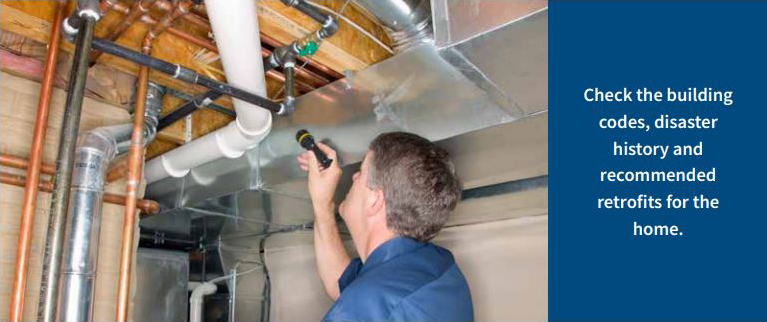The Home Selection Process
Starting the Search
Look for resilience information and find the right team
- Include resilience factors in your home search from the beginning and be sure to research the disaster history.
- Realtors and sellers may not know or be required to disclose information about hazard risk voluntarily.
- Professional home inspectors often don’t address hazard vulnerability unless it relates to required construction regulations or building codes.
- Know the resilience questions to ask your realtor, home inspector, mortgage broker, and insurance agent.
The first step to finding and purchasing a resilient home is understanding what risks you may face where you are buying.
You can start your search at Inspect2Protect.org* to identify the building codes used in the community, including whether it has adopted the International Residential Code (IRC) and International Building Code (IBC) models. You can also review the disaster history of the community, as well as historical code information and retrofit recommendations specific to the home’s current building code status. Try searching online for the address of the home and do the same search for all the perils, including earthquake, flood, hurricane, tornado, or wildfire.
*Inspect2Protect.org is funded by DHS Science & Technology Directorate, Systems Engineering and Standards Division, as well as FEMA.

You may also want to contact your local building or planning department to learn about the code enforcement requirements as they may be voluntary, mandatory, or nonexistent.
Consider also the disaster history for the broader area beyond your community. Just because a community hasn’t experienced disaster already doesn’t mean it won’t in the future.
Various tools show areas of past and expected weather or other disaster events, including these maps and resources:
- Earthquake: seismic design category (earthquake design in the International Residential Code), seismic-hazard maps (USGS – earthquake potential shaking), fault
map (USGS – interactive quaternary faults database), and landslide map (USGS – landslide inventory) - Flood: FEMA Flood Map Service Center (flood maps and other products)
- Hurricane: hurricane-prone regions (hurricane design in the International Residential Code), select windborne debris region (hurricane and high-wind design in the International
Residential Code), windborne debris region (hurricane and high-wind design in the International Residential Code), U.S. Hurricane Return Periods (NHC NOAA – frequency of return hurricanes), and CONUS Hurricane Strike Density Maps (NHC NOAA – history of hurricane strikes) - Tornado: U.S. Tornado Climatology (NOAA – various tornado resources)
- Wildfire: Wildfire Hazard Potential map (USDA Forest Service, Fire Modeling Institute) and Wildfire Risk to Communities map
You also can review the state or territory’s hazard mitigation plan. Local jurisdictions may have a hazard mitigation plan, as well.
Once you’ve completed your research, ask your realtor, mortgage broker, insurance company, or agent (and home inspector) what disasters have occurred or are typical for the community or neighborhood you are considering.
Professionals may not be required to disclose disaster history unless you ask. Write down your questions and their answers. Use your list to evaluate each professional you need to assist you in your home search and purchase.
Finally, your home inspector may not address your prospective home’s ability to withstand any disaster unless specifically related to the building code or home construction methods. However, you can ask the inspector to use the disaster-specific checklists (Appendix II) to help you learn more about the presence or absence of disaster-resistant home features and overall risk profile. You can also use those checklists to identify retrofits and upgrades that will make your prospective home stronger and more disaster resistant.





